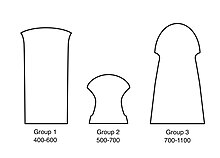Bildstein from Smiss (Stenkyrka)
The picture stone from Smiss in the parish of Stenkyrka on the Swedish island of Gotland comes from the end of the three-phase picture stone era . The example shows the typical representation of a ship, which is one of the motifs of the stones of the (last) type 3. The stone is now in the Statens Historiska Museum in Stockholm .
Between 700 and 1100 AD, the second pictorial stone style using representational elements asserted itself on Gotland. The drawings were no longer laid out geometrically or as outlines, as before, but pictorially and flat. The stones of this era are generally very high. The representation of a ship, on the stone that is only well preserved in the lower area, is the most detailed ever found. It coincides roughly with the real Viking ships from Gokstad and Oseberg . Missing elements in the ship finds, such as the rigging, can thus be added.
The hull has a dragon head on the bow and a rolled tail on the stern. On the mast top is a Viking Age ship's flag of the type that was often found as a scaled-down bronze model during excavations and as a grave goods in the Baltic Sea region. The picture stone, however, does not show an ornate metal ship's flag on the stem , like the original of the ship's flags from Heggen , Källunge , Söderala and Tingelstad . The sail is checked horizontally or diagonally on all Gotland picture stones ( Swedish picture stenars ). The diagonal lines on the sails should represent reinforcements made of leather. The longitudinally striped sail, which is often seen on the models of the Oseberg and Gokstad ships, did not come into use until the 11th century. At the lower end of the sail was a highly complex system of net sheets with numerous ends at which the crew could keep the sail as flat as possible in the wind.
Other picture stones come from the district Lilla Bjärs.
See also
literature
- Erik Nylén , Jan Peder Lamm: Picture stones on Gotland. Wachholtz, Neumünster 1981, 1991 (2nd edition), ISBN 3-529-01823-6 .
Web links
- Description (Engl.)
- Description (swedish)
